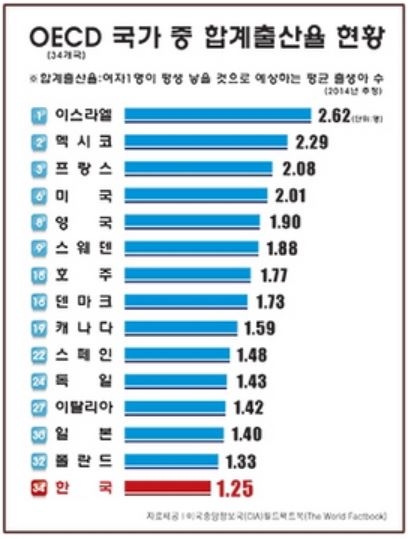Despite growth in child care spending, fertility remains stagnant
Relevant policies and institutions should cover more people

According to the recently released CIA World Factbook, Korea’s Total Fertility Rate which represents the average number of children that would be born to a woman over her lifetime is 1.25, ranking 219th among 224 countries. Among OECD countries, it is the lowest.
Indeed, Korea’s fertility rate has fallen to the lowest level since 13 years ago. After dropping below 1.3 in 2001, the rate further went down to 1.08 in 2005. Though there was a moderate recovery in 2012, it fell, once again, to 1.19 in 2013 when the government began offering free child care programs. Now, people are questioning the effectiveness of these schemes.

As part of its initiative to raise the fertility rate, the government has been increasing its budget for child care annually. The budget grew by 27.7%, this year alone, to KRW 5273.8 billion, most of which have been allocated to improve working conditions for child care workers and build public day care centers and comprehensive day care centers that provide temporary care assistance.
Nevertheless, most experts believe such initiatives did not prove effective due to lack of accessible infrastructure and underutilization of parental leave already in place. Furthermore, non-regular workers have not been entitled to these benefits.
Many experts suggest that the key is to develop a culture of work-life balance in which more people, especially fathers, would feel comfortable taking parental leave. This would ease the child care burden currently disproportionately imposed on mothers, encouraging them to give birth.
Most stay-at-home mothers heavily loaded with nursing and educating their first child are unsure whether they can afford a second child. Concerned about employment discontinuity, working moms are no exception. Under such circumstances, reaching the replacement level fertility of 2.1 or raising the employment rate of women to 70% seems so far way.
The Planned Population Federation Chair Son Sukmi pointed out “The private sector should provide full support such as guaranteeing wages for contingent workers so that both men and women would feel free to go on parental leave. Relieving the burden of child care and encouraging working moms to give birth to a second child are the fundamental solutions.” Son added “Though the government has been increasing its budget for child care, we still have a long way to go, when compared to other nations like France which made an exorbitant amount of investment in order to promote child birth and care.” Last year, the amount of money used to address the issue of low fertility in Korea stood at about 1% of its GDP, far below the average of 3~4% for advanced nations.
Having been criticized for proposing solutions that are only confined to infant and child care, the government should note that expensive after-school and private education is keeping mothers from having babies. The Korean Women’s Association United Secretary General Park Chaok-kyung said “Parents have a strong drive for private education. Without support, they can’t afford two children. In addition to relevant policies and institutions, we need to bring about changes in our perception and raise public awareness that both mom and dad need to commit to child care.”

